Exploring Electrostatic, Magnetic, and Electromagnetic Phenomena
Electroscope Experiment

We started off the day with exploring electrostatic phenomena! Emily provided each of the students with a block of Styrofoam, pie tin with a plastic cup attached, pop can, and a small strip of aluminum foil. Students were asked to rub a cloth back and forth along the the top of the Styrofoam block which has the same purpose as “peeling a piece of sticky tape off of a table.” Next they set their pie tin on top of the block and then against the metal pop can. The strip of aluminum foil moved away from the pop can and students experienced a shock!
Powerful Idea: You can create a separation of charges which you can get to move from one place to another.
Iron Filing Experiment
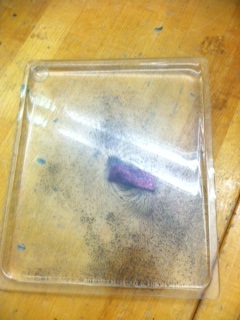
Emily showed the students a new way of seeing the iron filing experiment. This time, we had a container in which the iron filings were trapped. We saw the same results as we did previously with our experimentation with iron filings, but the students were really excited about having something where the filings are contained– which would be much easier to include in an elementary-aged classroom.
Powerful Idea: There is something outside of a magnetic which affects the magnetic field (iron filings).
Compass Experiment
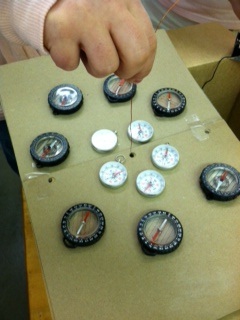
The students noticed that all of the compasses naturally point in same direction– one of the students explained that this is due to the earth's magnetic field. We live on a magnet and the compasses line up with that field. One of the students never knew how a compass worked until it was explained to her today.
Emily set up the experiment (as shown above). Several compasses were set around (in a circle) a thin wire. If we make a current go through a wire by connecting it to a battery and creating a complete circuit,the needles inside the compasses move. From this experiment, we are able to infer that the current moving through the wire creates some kind of magnetic field (which affected the compasses).
One of the students asked, “How do you explain this phenomena to your student who asks, 'when I put a magnet on the dirt, it doesn't stick… so how is the earth magnetic? This entire earth is acting like a magnet, but my magnet doesn't stick to it!'” Emily suggested that you would talk to your student about gravity, and how when you let something go from your hand, it falls to the earth. Also, let them know that they asked a great question.
Drawing Electromagnetic Phenomena
Emily asked one of the students to draw a balloon next to a wall on the white board and a person next to a balloon. She asked the students to think about the balloon being charged (rubbed) and what would happen when it came in contact with a wall or person's hair. This is what the student drew:
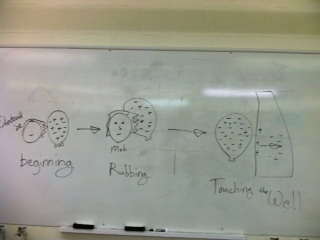
Powerful Idea: The balloon is attracted to the wall or hair because opposite charges attract.
Nail and Paperclip Experiment
Emily demonstrated for the students what would happen when she held a nail wrapped in wire close to a paperclip… nothing.
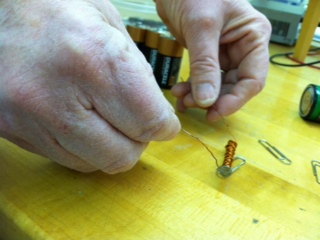
Next, she connected both ends of the wire which was wrapped around the nail to a battery to create a complete circuit. When held close to the battery, the coil acted as a magnet… the paperclip was attracted!
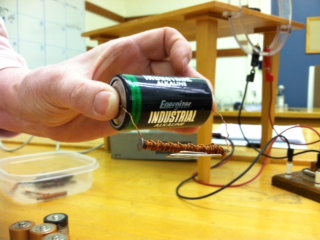
The students were surprised to see that the complete circuit acted as a magnet for the paperclip.
Jumping Wire Experiment

One last step before building a motor… Emily set up this experiment before class started. A wire was connected to two batteries and ran through two sets of magnets. As soon as the wire was connected to the batteries to create a complete circuit, it jumped up or down, depending on which way it was connected to the batteries (which way the current was flowing). This showed a small effect but is the basis in how a motor works.
Motor Effect Experiment
Each of the students were given a small plastic cup, small magnets, paperclips, copper wire (with half of each end sanded down) and batteries, which they set up like this:
\\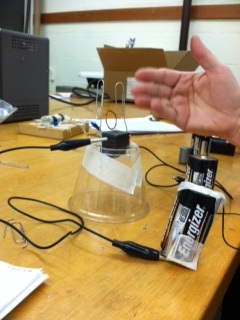
Current flows through the wire coil and creates an electromagnet.One face of the copper wire becomes the “north pole” and the other, the “south pole.” The magnet sitting on top of the cup attracts is opposite pole on the coil and repels its like pole, which causes the magnet to spin.
Powerful Idea: Materials inside the wire are spinning in such a way that they are making a magnetic field. Particular kinds of materials have electrons that spin which creates a magnetic field. We're moving towards being able to answer the question– what makes those electrons spin?